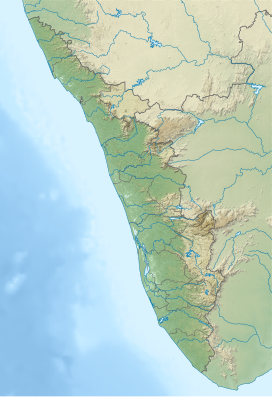Palakkad Gap
| Palakkad Gap | |
|---|---|
 Panorama view of Palakkad from Tamilnadu side | |
| Elevation | 140 metres (460 ft) |
| Location | Tamil Nadu - Kerala, India |
| Range | Western Ghats |
| Coordinates | 10°43′07″N 76°52′55″E / 10.718550°N 76.881966°E |
Palakkad Gap or Palghat Gap is a low mountain pass in the Western Ghats between Coimbatore in the Indian state of Tamil Nadu and Palakkad in the state of Kerala. It has an average elevation of 140 metres (460 ft) with a width of 24–30 kilometres (15–19 mi). The pass is located between the Nilgiri Hills to the north and Anaimalai Hills to the south.[1]
History
[edit]Palakkad gap has played a major role in enabling human migration into Kerala from parts of Tamil Nadu. From 300 BC to the 13th century, it also helped the Cheras rule the entire Kerala and the Kongu Nadu as one geographical unit from Karur in Western Tamil Nadu. Tamil Brahmins migrated to Palakkad from Central Tamil Nadu via the Palakkad gap from the 15th century to 18th century.[2]
Geography
[edit]

There are various theories about the origin of Palakkad gap. One among them is that it is caused by the landslide due to rivers flowing in opposite directions. The Bharathappuzha river from Pollachi, Tamil Nadu (River Ponnani) flows through the Palakkad Gap, collects water from various rivulets and tributaries feeding from steep escarpment slopes along the flanks of the Ghats.[3] Another theory suggests that the gap may be created by an asteroid strike around 800 million to 550 million years ago.[4]
A study published in 2008 suggest that it is the continuation of a Precambrian shear-zone that extended from east Africa through Ranotsara Gap of Madagascar to Palakkad Gap in India.[5]
There is also another theory which suggest that this Palakkad Gap is formed out due to a massive Asteroid attack at Coimbatore Area which leads to the formation of Kaveri Crater (it is considered to be fourth largest crater surface on the earth) and due to which a hill terrain which already existed in that area might be wiped out due to the massive impact which leads to the subsequent formation of Palakkad Gap.[6][7]
Effect on weather
[edit]The gap affects the weather patterns in Southern India as it allows the moisture-laden Southwest monsoon winds into western Tamil Nadu, moderating summer temperatures and generating greater rainfall in the region relative to the rest of lowland Tamil Nadu. It affects rainfall activity in parts of western Tamil Nadu, around Coimbatore, Palladam, Kangeyam, Dharapuram, Udumalai by allowing moisture laden winds from the West Coastal region of Kerala and Arabian Sea. It also allows the hot winds coming from Tamil Nadu which warm the eastern part of Kerala significantly compared to the rest of the state and the tropical cyclone winds from Bay of Bengal bearing rain during the summer.[citation needed]
Transport and trade
[edit]The gap is the lowest pass through the Western Ghats in the region. It is an important mountain pass in the Western Ghats that runs along the entire eastern edge of Kerala isolating it from the neighboring Tamil Nadu. It acts as an important transport corridor between the two States by linking Palakkad District of Kerala with Coimbatore District of Tamil Nadu and has served as a vital trade route between the east and west coasts of peninsular India since ancient times.
Both the National Highway 544 and the Jolarpettai - Shoranur railway line, Palakkad - Pollachi railway line joining Kerala to Tamil Nadu pass through the gap. The gap also helps for VHF line of sight communications between the states of Kerala and Tamil Nadu.
Wind energy
[edit]The Palakkad Gap funnels the winds blowing from the west on to Palakkad District in Kerala, Coimbatore and Tirupur districts in Tamil Nadu making the region one of the major wind power generation areas.[8] The average annual wind speed is 18–22 km/h.[9] Large windmill farms can be seen in and around Kanjikode, Chittur, Muthalamada, Kollengode, Pollachi, Kinathukadavu, Udumalaipettai, Dharapuram and Madathukulam.
See also
[edit]- Aryankavu mountain pass
- Aralvaimozhi
- Palakkad
Gallery
[edit]-
Palghat Gap as seen from Coimbatore-Shoranur railway line
-
Palghat Gap as seen from Palghat-Chitoor Road
-
Western Ghats as seen from Coimbatore-Shoranur rail line
-
View of Ghats
-
Palghat-Coimbatore NH 544 - NH 66 (re-numbered NH 47) runs through the gap
-
Southern end of the gap
-
One end of the gap
-
A passenger train in Palghat gap
References
[edit]- ^ "Britannica Encyclopedia". Retrieved 8 March 2015.
- ^ "History of Kerala Iyers, migration of Tamil Brahmins to Kerala". www.kuzhalmannamagraharam.info. Retrieved 9 September 2020.
- ^ Nair, Dr. S. Sathis Chandran, (20 May 2004). A Note on the Ecological Impact of the Proposed Pathrakkadavu Hydro-Electric Project (PHEP) in the Kunthi River, Palakkad District of Kerala: India - Silent Valley Rainforest Under Threat Once More
- ^ Did an asteroid hit south India millions of years ago?, (19 Jan 2019)Is the land between present day Nilgiris and Kodaikanal located on a crater formed by the impact?
- ^ Gunnell, Yanni; Harbor, David (1 June 2008). "Structural Underprint and Tectonic Overprint in the Angavo (Madagascar) and Western Ghats (India) - Implications for Understanding Scarp Evolution at Passive Margins". Geological Society of India. 71 (6): 763–779. ISSN 0974-6889.
- ^ "Kaveri Crater – An Impact Structure in the Precambrian Terrain of Southern India".
- ^ Subrahmanya, K. R.; Prakash Narasimha, K. N. (October 2017). "Kaveri crater – An impact structure in the Precambrian terrain of southern India". Journal of the Geological Society of India. 90 (4): 387–395. Bibcode:2017JGSI...90..387S. doi:10.1007/s12594-017-0733-5. ISSN 0016-7622. S2CID 134717819.
- ^ "Tiruppur District Official Webpage". Retrieved 6 November 2013.
- ^ "TamilNadu Energy Development Agency". Archived from the original on 7 November 2013. Retrieved 6 November 2013.
External links
[edit]- View of Palghat Gap from the Nelliampathy Mountain ranges









